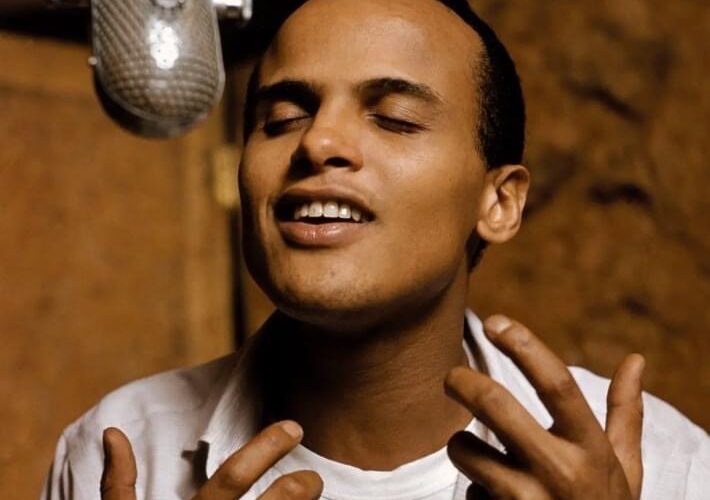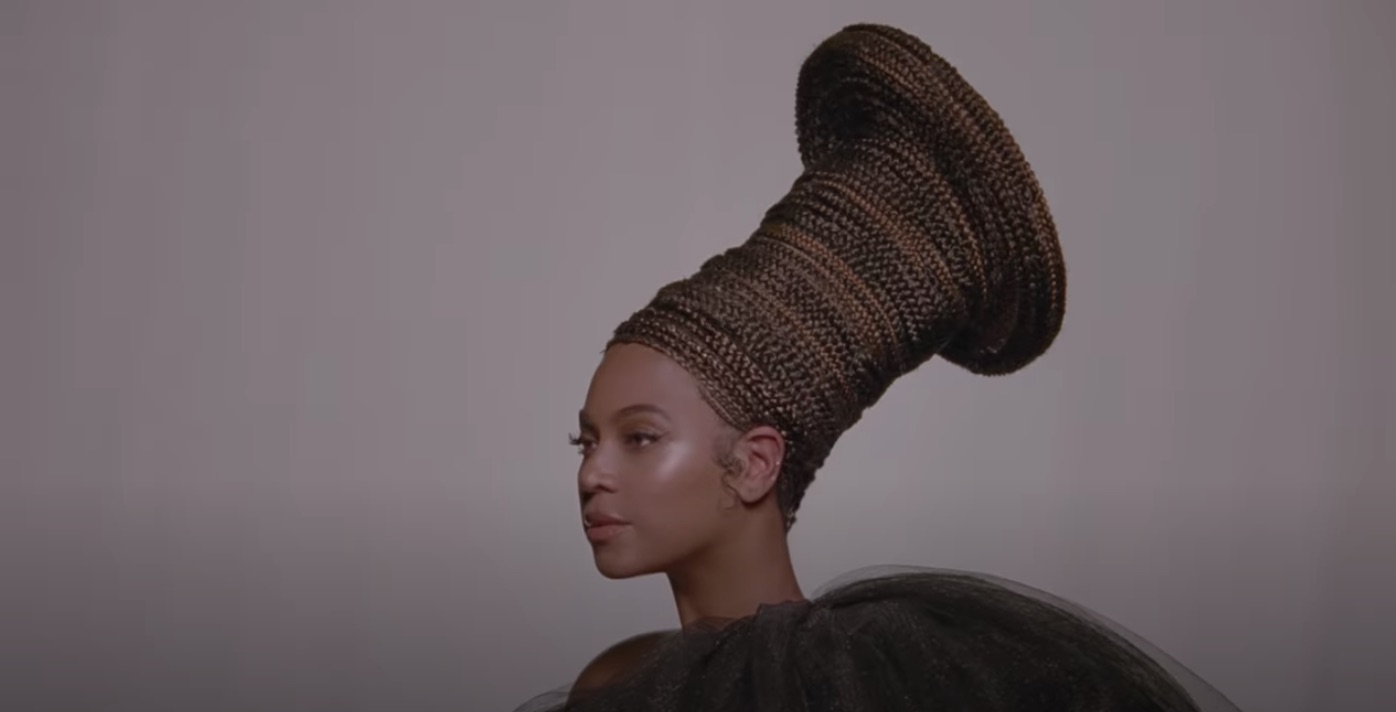Recording Academy members convened at the Capitol to advocate against using lyrics in court proceedings. The Guggenheim Museum announced it would present Going Dark: The Contemporary Figure at the Edge of Visibility. Human rights activist and EGOT (Emmy, Grammy, Oscar, Tony) winner Harry Belafonte passed away at 96. And Barbara Walker made the shortlist for the Tate Prize. Read more in This Week in Black Art and Culture.
Recording Academy Fights Against Rap Lyrics Being Used in Court
Recording Academy leaders and members joined Congressmen Hank Johnson (D-GA) and Jamaal Bowman (D-NY) at a press conference on Capitol Hill on Thursday to announce the reintroduction of the Restoring Artistic Protection Act. Intended to protect artists’ freedom of creative expression, the Restoring Artistic Protection Act would limit the use of song lyrics in court. This common practice that disproportionately affects rap and hip-hop artists. Artists and industry advocates including Academy CEO Harvey Mason Jr. and Academy Black Music Collective Chair Rico Love shared their views on the importance of passing this legislation and ensuring all artists can create freely without fear of their work being criminalized.
“GRAMMYs on the Hill has been bringing music creators to Capitol Hill for more than 20 years to elevate policy issues that impact our community,” said Harvey Mason Jr., CEO, Recording Academy and Rico Love, Chair, Recording Academy Black Music Collective in a joint statement. “Today, we’re proud to see our Academy members’ commitment to advocacy come to life with the reintroduction of the Restoring Artistic Protection Act. We must safeguard artists’ freedom to create at all costs and work to eradicate the biases that come with the unconstitutional practice of using lyrics as evidence. We are grateful to Congressmen Johnson and Bowman for their unwavering commitment to music people and look forward to working alongside them to advance this issue.”
The announcement comes on the heels of the Recording Academy’s Annual GRAMMYs on the Hill, a two-day event that honored 13-time GRAMMY winner Pharrell Williams, Senate Majority Leader Chuck Schumer (D-NY) and Senator Bill Cassidy (R-LA) for their stalwart support of music creators and connected music creators, with members of Congress from both sides of the aisle advocating for the Restoring Artistic Protection Act, the HITS Act, the American Music Fairness Act, and reform of the live-event ticketing marketplace.
“This legislation is long overdue,” said Congressman Johnson. “For too long, artists–particularly young Black artists–have been unfairly targeted by prosecutors who use their lyrics as evidence of guilt, even though there is no evidence that the lyrics are anything more than creative expression. When you allow music and creativity to be silenced, you’re opening the door for other realms of free speech to be curtailed as well. The government should not be able to silence artists simply because they write, draw, sing, or rap about controversial or taboo subjects. The Restoring Artistic Protection Act (RAP Act) would protect artists’ First Amendment rights by limiting the admissibility of their lyrics as evidence in criminal and civil proceedings.”
There are over 500 documented cases since the 2000s where prosecutors have used lyrics as criminal evidence in court against an artist defendant. A 2016 study by criminologists at the University of California examined whether rap lyrics are evaluated using stereotypes and found that rap was evaluated more negatively than other genres of music, highlighting the possibility that bias against rap lyrics could inappropriately impact jurors when admitted as evidence to prove guilt.
On Sept. 30, 2022, California Governor Gavin Newsom signed the Decriminalizing Artistic Expression Act into law alongside Harvey Mason Jr. at a virtual bill signing. This year, the Academy is working to advance similar legislation in several states, including Louisiana, where HB-475 passed a House vote on April 25; Missouri, where HB-353 recently advanced to the House for a vote; and New York, where a similar bill passed through the Senate in 2022.
Going Dark Exhibition To Open at the Guggenheim
The Guggenheim Museum presents Going Dark: The Contemporary Figure at the Edge of Visibility, a major exhibition predicated on a duality: works of art that present the figure, yet obscure it in some way, thus existing at the “edge of visibility.” The exhibition asserts that these experimentations in figuration across media—painting, photography, drawing, prints, sculpture, video and installation—articulate pressing questions about what it means to be seen, not seen, or erased in society. On view from Oct. 20, 2023 through April 7, 2024, the exhibition features 28 artists and fills all six ramps of the museum’s Frank Lloyd Wright-designed rotunda. Going Dark: The Contemporary Figure at the Edge of Visibility is organized by Associate Curator, Contemporary Art Ashley James, with Curatorial Assistant Faith Hunter.
The artists in this exhibition “go dark” through a range of formal moves, including, but not limited to, literal darkening by way of shadowing or other lighting techniques; paint selections; reversing or otherwise concealing the body; and post-production tools such as “chroma-keying.” Going Dark suggests that these approaches to the figure allow for engagement with urgent and ongoing discussions around visibility in its social context: both invisibility and hypervisibility within public and private spaces, as well as within institutions, (art) history, popular media, social media and more.
Through revealing and concealing the body, Going Dark probes a key point of conflict in representation: both the desire to be seen and the desire for obscurity, especially as technology offers more opportunities for (and dangers in) exposure than ever before. This exhibit features over 100 works of art by a multigenerational, multiracial group of artists, the majority of whom are Black and more than half of whom are women. Chronologically, the show proceeds from the mid-1980s, with paintings and photographs by Kerry James Marshall, Lorna Simpson and Ming Smith, to the present, with photography, sculpture, and video works by Sandra Mujinga, Sondra Perry, Stephanie Syjuco and others.
Works from the late 1960s to early 1970s by David Hammons, Faith Ringgold and Charles White offer earlier reference points for the contemporary history this show presents. Tiona Nekkia McClodden and WangShui will debut new paintings, and American Artist will present a new site-specific installation.
While focused on the social contexts of visibility, Going Dark also argues that this “semi-visible” figuration as a genre is one of art historical significance, intervening upon discourses of modernism and the monochrome. The works in the show move fluidly between figuration and abstraction, thus blurring the lines in that staid binary frame. Recognizing that making art at the limits of the visible requires new materials, tools and processes, many of the artists featured in Going Dark inventively manipulate color and light to obscure both social and optical perception, challenging the very biology of how we see.
A robust catalog will be published to accompany the exhibition, featuring newly commissioned essays by curators and scholars Jordan Carter, Ayanna Dozier, Ashley James, Key Jo Lee, Abbe Schriber and Legacy Russell. Also included are creative responses to the concept of “going dark” by seven poets and graphic designers: Rio Cortez, Harmony Holiday, Marwa Helal, Kristian Henson, Nontsikelelo Mutiti, Hassan Rahim and Kevin Young. The book is designed by Fahad AlHunaif.
Remembering Harry Belafonte
Harry Belafonte, a musician, actor and human rights advocate, passed away on Tuesday at the age of 96 from congestive heart failure. He overcame racial boundaries and managed to combine his artistic talent with his advocacy in a way that captivated audiences all over the world. According to his spokesperson, Belafonte, an EGOT recipient (with Emmy, Grammy, Oscar and Tony accolades), passed away at home in New York, his wife Pamela by his side.
Belafonte was born in Harlem, New York. Both of his parents were from the Caribbean, his mother from Jamaica, and his father from the island of Martinique.
He briefly resided in Jamaica before returning to his home in New York City and served in the U.S. Navy during World War II. Subsequently, he studied acting under Sidney Poitier and Ruby Dee at the American Negro Theatre while earning money as a nightclub singer. He was honored with a Tony Award in 1954 for his performance in the revue John Murray Anderson’s Almanac: A Musical Harlequinade.
He appeared on TV variety shows and as a movie star. He had a one-hour show on CBS in 1959. The event, The Revlon Revue: Tonight With Belafonte, featured both Black and white artists as well as dance routines and folk tunes. The show received the first Emmy Award for an African American.
Belafonte rose to fame after his 1956 album, Calypso, which included Day-O, was released. The first album ever to sell one million copies was Calypso. Though Day-O might be the song that people today most associate with Belafonte, it was merely one of many top hits from his more than 30 albums that were released over his long career.
Matilda, which initially was published in 1953, became one of Belafonte’s hallmark tunes. Other well-known songs include Mama Look a Boo Boo, Jamaica Farewell, and Island Farewell. Jump in the Line (Shake, Senora) was a 1961 hit. Being a confidant of Dr. Martin Luther King, Jr. (1929–1968), Belafonte supported the Civil Rights Movement from the start, contributing both time and money to the cause.
He participated in the planning of the 1963 March on Washington, organized voter drives, and donated money to the Student Nonviolent Coordinating Committee and the Freedom Rides, releasing King and other civil rights activists on bail. In addition to the Kennedy Center Honors and the National Medal of Arts, he earned the Jean Hersholt Humanitarian Award and the Springarn Medal from the NAACP.
Artist Barbara Walker Shortlisted for Turner Prize by Tate Britain
Tate Britain yesterday announced the four artists who have been shortlisted for the Turner Prize 2023, one of whom is a Black artist, Barbara Walker. An exhibition of their work will be held at Towner Eastbourne, East Sussex United Kingdom from Sept. 28-April 14, 2024 as a major moment in the gallery’s centenary celebrations. The winner will be announced on Dec. 5 at an award ceremony in Eastbourne’s Winter Gardens.
Barbara Walker, a British artist who draws huge portraits of Black people onto gallery walls, and Jesse Darling, a sculptor whose works evoke fragile bodies, are among the artists nominated for this year’s prize. Walker was nominated for her presentation, Burden of Proof, at Sharjah Biennial 15. With a practice that interrogates past and present issues of racial identity, exclusion and power, Walker’s presentation explores the impact of the Windrush scandal that began in 2018, where many people, mainly from Caribbean countries, including born British subjects, were wrongly deported, underlaying figurative-drawn portraits with facsimiles of the documentation these individuals had to produce to prove their right to remain.
The Windrush generation arrived in the U.K. on revolutionary cruise ship liners in the 1930s, departing from the Caribbean after World War II. The jury applauded Walker’s ability to use portraits of monumental scale to tell stories of a similarly monumental nature, while maintaining a profound tenderness and intimacy across the full scope of her work. One of the world’s best-known prizes for the visual arts, the Turner Prize aims to promote public debate around new developments in contemporary British art.
Established in 1984, the prize is named after the radical painter JMW Turner (1775-1851). It is awarded each year to a British artist for an outstanding exhibition or other presentation of their work. The Turner Prize winner will be awarded £25,000 (U.S. $31,415), with £10,000 (U.S. $12,566) awarded to the other shortlisted artists.










